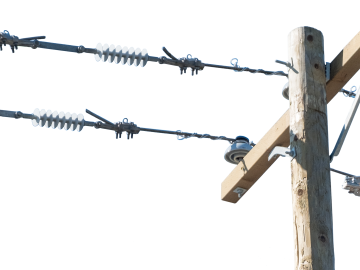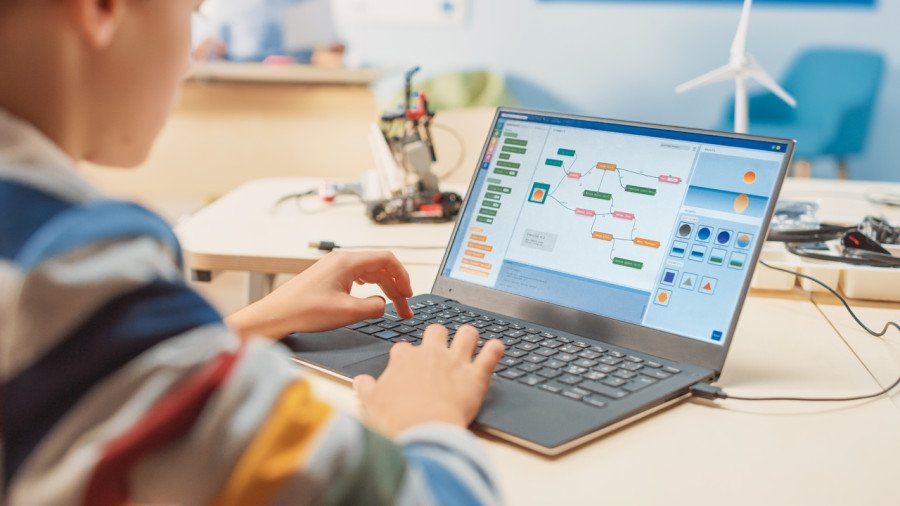Safety around power lines
Learn about the ways electricity can travel, code an electrical safety message, and play a game testing your electrical safety knowledge.
- Grades 4-7
- 2 activities
- 1.8 hours

Big idea
Science 4
Energy can be transformed.
Science 7
The electromagnetic force produces both electricity and magnetism.
Learning objectives
Students will be able to:
- Respond safely to electrical safety hazards like downed power lines
- Understand the various ways electricity travels including touch potential, step potential and arcing
- Learn basic coding skills using creativity, critical thinking and logic
Activities

Coding safety messages
Learn coding skills by programming your own interactive safety message.
BC curriculum fit
Science 4 & 7
Curricular competencies
Applying and innovating
- Co-operatively design projects
- Transfer and apply learning to new situations
Communicating
- Represent and communicate ideas and findings in a variety of ways, such as diagrams and simple reports, using digital technologies as appropriate
Physical and Health Education 4, 5, 6, 7
Content
- Strategies and skills to use in potentially hazardous or unsafe situations (Grade 4)
- Basic principles for responding to emergency situations: following safety guidelines (Grade 6, 7)
Curricular competencies
Social and community health
- Identify and describe strategies for avoiding and/or responding to potentially unsafe, abusive, or exploitive situations
Career Education 4, 5, 6, 7
Content
- Goal-setting strategies - emergent leadership skills, safety hazards and rules at school, at home, and in the community (Grade 4, 5)
- Personal development leadership (Grade 6, 7)
Curricular competencies
- Demonstrate safe behaviours in a variety of environments (Grade 4, 5)
- Demonstrate safety skills in an experiential learning environment (Grade 6, 7)
Applied Design, Skills and Technologies 4, 5, 6, 7
Content
- Develop foundational mindsets and skills in design thinking and making (Grade 4, 5)
- Computational thinking (Grade 6, 7)
- Visual programming for example, scratch
Curricular competencies
Applied technologies
- Demonstrate a willingness to learn new technologies as needed (Grade 4, 5)
Prototyping (Grade 6, 7)
Testing (Grade 6, 7)
Assessments
The activities in this unit provide an opportunity to assess individual students and groups on their ability to:
- Respond safely to an electrical safety hazard like a downed power line
- Understand concepts of touch potential, step potential, and arcing
- Participate in a group setting with respect and cooperation
- Practice creative, critical and logic thinking
- Learn basic coding skills and teach others to stay safe around power lines
Background info
Electrical safety tips
- Never put fingers or other objects in an outlet
- Keep metal objects out of toasters
- Never use anything with a cord or plug around water
- Never pull a plug out by its cord
- Stay away from substations and power lines
- Don't climb on power poles
- Never fly kites near power lines
- Stay away from broken or fallen power lines
- Never touch or climb trees that are near power lines
- Never touch big, metal transformer boxes with warning sign
- Obey warning signs
Electrical safety, electricity and power lines
Power lines are conductive meaning the electrical current runs through them with the least resistance. However if something makes contact with a live power line like a tree, kite, or ladder, the electrical current may flow to the ground. The place where the current touches the ground is the highest voltage and from that point the electrical current spreads out in irregular concentric circles. The voltage or electrical intensity decreases as it moves further from the source. 10 metres or more from the source of contact, like a downed power line, is a safe distance.
Touch potential is the ability electricity has to find its way through touch to get to the ground. If a kite gets tangled in a power line, the electrical current could travel through the kite and you to reach the ground. Birds do not get zapped when standing on a power line, however they would if they straddled two power lines, or touch their beak to the ground while standing on the power line.
Step potential is the ability electricity has to move through your body as you step away from the source of electricity. As electrical current flows through the ground the voltage decreases in concentric rings or ripples as you move further from the source. However, if you move away by lifting one foot, the change in voltage between the concentric rings can travel up one leg and down the other. Instead by keeping your legs together and shuffling your feet, the electrical current will stay in the ground. 10 metres is the safe distance calculated based on the voltage in the power lines here in B.C.
Arcing is the ability electricity has to jump through the air to find a path to ground. The term arcing describes the shape the electrical current uses to get to the ground. Some jobs around your home may take you close to power lines, such as trimming trees, working on your roof, or doing exterior renovations. It is important to keep yourself and any tools you’re using at least three metres (the length of a four-door car) away from power lines near your home. This is because electricity can "arc" or jump from power lines across a gap, to tools or ladders that you're using.
Scratch: Imagine, program, share
Even without an account, you can play other people's projects, read comments and forums, and even create your own projects. But you need an account to save and share projects, write comments and forum posts, and participate in other "social" activities in the community (like "loving" other people's projects).
Use this link for FAQ about scratch, to access resources and get a teacher account: https://scratch.mit.edu/educators/faq


